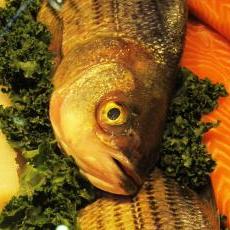






When it comes to local and sustainable foods, Metcalfe’s Market in Madison and Wauwatosa has invested much time and effort into providing an ample supply of locally grown and raised produce, cheeses, meats and seafood throughout the store.

One initiative in particular, a sustainable seafood program focused on providing safely caught,environmentally friendly seafood choices for customers, has gained local and national attention from organizations, grocers and distributors alike.
The local family-owned grocery store, was just named Wisconsin's number one supermarket for sustainable seafood by Greenpeace.
Greenpeace, an international organization focused on environmental issues, also named Metcalfe’s among the top 10 supermarkets in the nation, according to their “supermarket scorecard” that evaluates sustainable seafood programs in grocery stores across the nation.
Scoring an 8.3 out of 10 on their scorecard, Metcalfe’s received high marks for their seafood policy, promotion and labeling of seafood products and sustainability initiatives.
But these high marks did not come without hard work, Metcalfe’s Chief Food Officer and Local Food Liaison, Chef Leah Caplan said.
Metcalfe’s sustainable seafood program began with research, Caplan, who initially introduced the idea for the program to the store and led its further development, said.
“The first thing I determined was [sustainable seafood] is an incredibly, incredibly complex issue and I would need a lot of help,” she said.
To fill this need, Metcalfe’s sought a partnership with the non-profit organization FishWise to help the store adhere to strict sustainable seafood standards established by the seafood conservation organization Monterey Bay Aquarium.
These standards for sustainability change regularly based on a number of variables, including how the seafood is caught and the environmental impact of fishing or farming certain species, Metcalfe’s Seafood Manager Bradley Edmunds said.
Fishwise then acts as a liaison between the store and Monterey Bay Aquarium to provide research-based support to stores on questions of sustainable seafood and which seafood distributors comply with standards, he said.
This service is particularly useful when Metcalfe’s receives information about distributors or sellers whose produce fails to meet Monterey Bay Aquarium regulations, Caplan said.

“There are a lot of regions or producers who will say they are sustainable, [but] it actually doesn’t align with the same sustainability requirements that FishWise and Monterey Bay Aquarium have, and therefore we have,” she said. “We constantly have to vet our suppliers and our vendors… we can’t just take anybody’s word in saying they are sustainable.”
Along with helping Metcalfe’s adhere to these standards, FishWise also implemented a color coded system of labeling seafood to help customers discern which products are sustainable (green), unsustainable (red) and a good alternative (yellow).
The organization also provided Metcalfe’s with in-store brochures, pamphlets and information to share with customers, Edmunds said.
This information educates customers about what sustainability means and how they can choose to make responsible choices when buying seafood, an important goal of the sustainable seafood program, he added.
But despite the simple labeling system and brochures, educating customers about sustainable and unsustainable seafood still poses a challenge, Caplan said.
When it comes to unsustainable seafood, also called red-list items, the demand from the grocery industry and other retailers for a year-round, inexpensive supply of seafood has led to the development of large fish farms, many of which have few restrictions or regard for the environment, Caplan said.
Large supplies of popular red-list items like shrimp and salmon create cheaper prices for customers. So once customers have paid five dollars for unsustainable shrimp, they are reluctant to pay $20 for sustainable shrimp.
Metcalfe’s currently still carries unsustainable seafood products for the sake of consumers demanding them, Caplan said.
“The grocery industry has created the problem in many ways… we demand [red-list items] because that’s what our customers want. What [Metcalfe’s] is doing and what the goal is [of the sustainable seafood program] is almost counterintuitive in the retail environment,” she said.
As customers learn more about the importance of sustainable seafood and understand the reasons for increased prices, the store plans to gradually eliminate red-list items, Caplan said.
While prices for both the store and customers have increased, moving to sustainable seafood has been good for business as the store has seen a marked increase in people buying sustainable seafood and supporting the program, Caplan said.
In fact, other stores in the area have also begun adopting sustainable seafood programs.
Just last September, Whole Foods Market announced a partnership with Monterey Bay Aquarium to label their seafood with the increasingly familiar green, yellow and red sustainability markers and eliminate their red-list items by Earth Day 2013, according to a Monterey Bay Aquarium release.
Whole Foods held third place behind Super Target on Greenpeace’s “supermarket scorecard” with a score of 6.2 out of 10 for seafood sustainability.
As for the grocery stores trailing Metcalfe’s in the rankings, Caplan predicts consumers will continue to see more sustainable seafood efforts across Madison and beyond.
Metcalfe’s itself remains only in the early stages of their sustainable seafood program, she added. In the future, the store plans to include sustainable fish in their deli, stock more green-labeled frozen seafood and start carrying shelf stable sustainable seafood items.
|
|
|
Welcome to the Madison Commons, a website designed to provide news and information about all of Madison's neighborhoods and a crossroads for the discussion of community issues. The name comes from the idea of a village commons, a place for news, talk, debate, and some entertainment, too, that's open to everyone.
All rights reserved. Read more about the Madison Commons and its partners.

